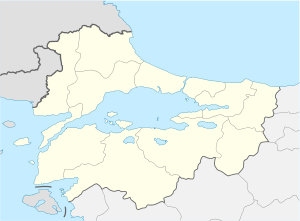Karaağaç, Edirne
Karaağaç (English: "elm, elm wood", Greek: Παλαιά Ορεστιάδα or Καραγάτσι) is a suburb of Edirne in northwestern Turkey at the border with Greece. Karaağaç is 4 km southwest from the center of Edirne, across the river Maritsa and opposite the Greek village Kastanies. In 1890, the large Karaağaç railway station was built in the town, which also served Edirne, becoming the last train stop in Turkey to Europe. In 1971, Turkish State Railways (TCDD) constructed a new railway station at the opposite side of the river, abandoning the former one, which is now used as Trakya University's Faculty of Fine Arts..
Karaağaç | |
|---|---|
 Karaağaç Location of Karaağaç in Turkey  Karaağaç Karaağaç (Turkey) | |
| Coordinates: 41°39′20″N 26°31′30″E | |
| Country | |
| Region | Marmara Region |
| Province | Edirne |
| District | Edirne |
| Time zone | UTC+2 (EET) |
| • Summer (DST) | UTC+3 (EEST) |
| Postal code | 22050 |
| Area code(s) | +(90)284 |
| Licence plate | 22 |
| Website | |
The Treaty of Lausanne Monument and Museum, which opened in 1998, are located next to the former railway station.[1]
History
When Greece held the town (1920-1923), Karaağaç was renamed Orestias, in remembrance of the ancient Thracian town with the same name, which probably lay near or at the site of present-day Edirne. Orestias or Orestia is thought to have been the same town as Uscudama (other variants: Uskudama, Uskadama, Uskodama) or Odrysa (other variants: Odrysia, Odrysos, Odrysus) which was the first Odrysian capital.[2] Orestias took its name by the Greeks, at least from the time Philip II of Macedon took over the town. The Roman emperor Hadrian expanded the town into a city, gave it a strong fortification and renamed it Hadrianopolis. However the name Orestias was still used by many writers at the Byzantine era, along with Adrianoupolis.[3][4][5]
References
- Güler, Olgay (2014-07-25). "Lozan'ın sönüşü". Edirne Hudut (in Turkish). Retrieved 2015-05-15.
- Duridanov, Ivan. The Language of the Thracians
- Anthon, Charles (1842). A Classical Dictionary, containing an account of the principal proper names mentioned in ancient authors, Harper and Brothers, New York. online. External link in
|title=(help) - Smith, William (1854). Dictionary of Greek and Roman Geography, London. online. External link in
|title=(help) - Mannert, Konrad (1812). Geographie der Griechen und Römer, Band 7, Nuremberg. online. External link in
|title=(help)